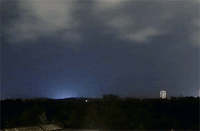Asteroid
2016 TH passed by the Earth at a distance of 128 300 km (0.34 times
the average distance between the Earth and the Moon, 0.09% of
the average distance between the Earth and the Sun), at about 4.30 pm GMT on Monday 3 October 2016. There
was no
danger
of the asteroid
hitting us, though had it done so it would have presented no
threat. 2016 TH has an estimated equivalent diameter of 2-7
m (i.e.
it is estimated that a spherical object with the same volume would be 2-7 m in diameter), and an object of this size would be expected to
explode in an airburst (an explosion caused by superheating from
friction with the Earth's atmosphere, which is greater than that caused
by simply falling, due to the orbital momentum of the asteroid) in the
atmosphere more than 36 km above the ground, with only fragmentary
material reaching the Earth's surface.
2016 TH was discovered on 2 October 2016 (the day before its closest approach to the Earth) by the University of Arizona's Mt. Lemmon Survey at the Steward Observatory on
Mount Lemmon in the Catalina Mountains north of Tucson. The designation
2016 TH implies that the asteroid was the eighth object (object H)
discovered in the first half of October 2016 (period 2016 T).
2016 TH has a 369 day orbital period and an elliptical orbit tilted at
an angle of 1.07° to the plain of the Solar System
that
takes it from 0.74 AU from the Sun (i.e. 74% of the average distance at
which the Earth orbits the Sun and slightly outside the orbit of Venus)
to 1.27 AU from the Sun (i.e. 127% of
the average distance at which the Earth orbits the Sun).
It is therefore classed as an
Apollo
Group Asteroid (an asteroid that is on average further from the Sun than
the Earth, but which does get closer). This
means that close
encounters between the asteroid and Earth are very common, with the
last thought to have happened in October 2016 and the next predicted in August 2017. 2016 TH also has occasional close encounters with the
planet Venus, with the last thought to have occured in October 2004 next predicted for April 2042.
See also...
 Asteroid 2016 TD passes the Earth. Asteroid
2016 TD passed by the Earth at a distance of 226 200 km (0.59 times
the average distance between the Earth and the Moon, 0.15% of
the average distance between the Earth and the Sun), at about 5.15 pm GMT on Friday 30 September 2016...
Asteroid 2016 TD passes the Earth. Asteroid
2016 TD passed by the Earth at a distance of 226 200 km (0.59 times
the average distance between the Earth and the Moon, 0.15% of
the average distance between the Earth and the Sun), at about 5.15 pm GMT on Friday 30 September 2016...  Fireball over the Eastern Great Lakes region. The American Meteor Society has
received reports of a bright fireball meteor being seen over parts of
the Eastern Great Lakes region slightly after 10.35 pm on Tuesday 4
October 2016 Eastern Daylight Time (slightly after 2.35 am on Wednesday 5...
Fireball over the Eastern Great Lakes region. The American Meteor Society has
received reports of a bright fireball meteor being seen over parts of
the Eastern Great Lakes region slightly after 10.35 pm on Tuesday 4
October 2016 Eastern Daylight Time (slightly after 2.35 am on Wednesday 5...  Fireball over Cyprus. The Cyprus Astronomical Society has reported a bright fireball meteor
over the island at about 1.00 am local time on Friday 9 September 2016.
The meteor is described as having a faint blue...
Fireball over Cyprus. The Cyprus Astronomical Society has reported a bright fireball meteor
over the island at about 1.00 am local time on Friday 9 September 2016.
The meteor is described as having a faint blue...
Follow Sciency Thoughts on Facebook.

